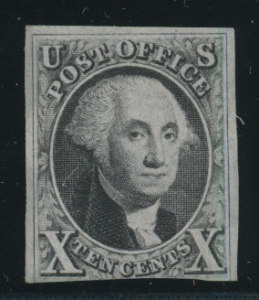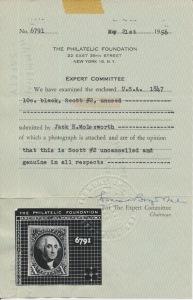Stamp certification never provides absolute certainty to stamp buyers. Expert committees in the United States are very clear that they offer only an opinion, not a guarantee. Their legal boilerplate, which every owner signs when he commits his stamps or covers to the expertization process, stipulates that the opinion is just that, an opinion, and that if the stamp or cover should later prove to be a forgery or repaired, well (and this is couched in a bunch of legal mumbo-jumbo), tough luck. Grading standards change as does the equipment available for determining the genuine from the fake. For many years an ultraviolet light was the tool of choice for determining whether or not an early US classic was mint or had a cleaned pen cancel. Later technology with magnification and light has made that way of determining the genuiness of great rarities seem rather quaint. In addition, the ability of stamp doctors to make hinge marks disappear, so that stamps can command the huge NH premiums now being paid, was made more difficult several years ago by technology that supposedly can show any tampering with the integrity of the gum.
My concern, however, is not with what we know but with what we don’t know. The money involved in faking and altering highest end US stamps is so tempting that it’s hard to believe that the science of alteration isn’t ahead of the science of detection. We have seen in the past in stamp expertizing that experts are good at comparing stamps against known genuine and altered stamps, and when new ways of altering philatelic material is discovered it takes a very long time to even identify that such material is appearing. Anyone who doubts this as a very real danger need only look at the world of competitive cycling where Lance Armstrong cheated for years despite hundreds of the most sophisticated tests that medicine could devise and the fact that many of the most sophisticated physicians were convinced that he was cheating and were doing their best to prove it.
So the issue is not whether or not stamps are currently being doctored, but how collectors can best protect themselves from the possibility that they might be. American style certificates of genuineness are a good start, but they offer no financial guarantee, and American philatelists even show their lack of confidence in our certifying boards by having many stamps continuously re-certified. A certificate or an opinion of genuineness that has no financial backing is pretty much worthless in the long run. We need a system in the United States like the one that they have in Germany. The German Bundrsprufer organization guarantees their certificates and signatures. If a stamp later turns out to be a fake or repaired, the owner is paid out of an insurance fund that the group of experts who make up the Bunderprufer federation have established.
However, there are two easy ways that collectors can protect themselves. First, there are only a small percentage of stamps in the philatelic firmament that have been forged or repaired. By staying away from collecting these stamps, or only collecting hinged or used stamps in the classic era, a collector removes most of the risk of buying a bad stamp, whether certified or not. Or, most importantly, provide yourselves with an iron clad guarantee of genuineness and description which has protected collectors for over a hundred years and on which every collector has been refunded in full if their stamps turned out not to be completely genuine and as described, with no fine print. That last option would be the easiest. And it would mean buying your stamps from the only stamp dealer in the world that offers that guarantee- that is from Apfelbaum.



